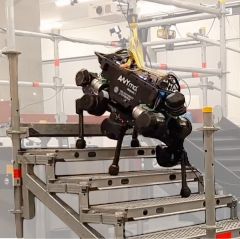Legged locomotion is a core motor skills needed to transverse challenging terrains and to reach any place. With these skills, legged robots can deliver substantial advantages by offering mobility that is unmatched by wheeled counterparts. These motor skills require are highly dynamics and complex as the robots need to balance and negotiate with the conditions of the environment. It requires to build motion planning and control, perception and estimation modules. Our lab has substantial experience in advancing and developing these modules.

Achieving agile maneuvers through multiple contact phases has been a longstanding challenge in legged robotics. It requires to derive motion plans and local control feedback policies in real-time to handle the nonholonomy of the kinetic momenta. Furthermore, it is also important to consider the robot’s actuation capabilities to achieve these maneuvers.
We propose a predictive controller that models the contact phases using a hybrid paradigm. Our predictive controller handles the robot’s actuation limits, a necessary condition to achieve jumping maneuvers on the ANYmal robot. We demonstrate that robots can generate the angular momentum properly with optimal local controllers in the form of feedback policies. Our approach is a step towards enabling athletic intelligence in legged robots.
Bringing the gap between what legged robots can do requires to carefully plan motion and foothold planning over challenging terrains. Planning whole-body motions while taking into account the terrain conditions is a challenging problem for legged robots since the terrain model might produce many local minima. However, mathematically speaking, this problem is hard to solve due to contact discontinuities, nonlinear, high-dimensional and under-actuated dynamics.
We propose a coupled planning approach that uses stochastic and derivatives-free search to plan both foothold locations and horizontal motions due to the local minima produced by the terrain model. It jointly optimizes body motion, step duration and foothold selection while considering the terrain uncertainties modelled as a cost-map. We validated our method across different challenging terrains: stairs, stepping-stones, and gaps.
Traditional motion planning approaches for multi-legged locomotion divide the problem into several stages, such as contact search and trajectory generation. This helps us to avoid the combinatorial nature of selecting footstep regions and gaits. However, reasoning about contacts and motions simultaneously is crucial for the generation of complex whole-body behaviors.
We propose a mixed-integer convex formulation to plan simultaneously contact locations, gait transitions and motion, in a computationally efficient fashion. Our approach is not limited to flat terrain nor to a pre-specified gait sequence. We experimentally validated the approach on the HyQ robot by traversing different challenging terrains, where non-convexity and flat terrain assumptions might lead to sub-optimal or unstable plans.
Stability metrics such as the contact wrench cone (CWC) has recently gathered interest within the legged robotics community. However, those metrics do not take into consideration actuator force/torque limits. We believe that these limits gain paramount importance when the complexity of the terrains to be traversed increases.
We build on previous research from the field of robotic grasping. We propose two new six-dimensional bounded polytopes named the feasible wrench polytope (FWP). Our polytope considers the robot’s stability in a similar fashion to the CWC. We present an implementation of a motion planner for the quadruped robot HyQ to demonstrate the usefulness of the FWP.